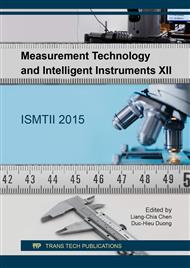[1]
Robert Baron, Plamondon, Rejean, Acceleration measurement with an instrumented pen for signature verification and handwriting analysis, IEEE Trans. Instrum. Meas. 38 (1989) 1132-1138.
DOI: 10.1109/19.46414
Google Scholar
[2]
T. Miyagawa, Y. Yonezawa, K. Itoh, M. Hashimoto, Handwritten pattern reproduction using 3D inertial measurement of handwriting movement, Trans. Society Instrum. Contr. 38 (2002).
DOI: 10.9746/sicetr1965.38.1
Google Scholar
[3]
Y. Sato, T. Inoue, E. Fujisawa, T. Kitaguchi, T. Furuta, N. Murata, M. Shingyouchi, U.S. Patent 5981884. (1999).
Google Scholar
[4]
Sung-Jung Cho, Jong Koo Oh, Won-Chul Bang, Wook Chang, Eunseok Choi, Yang Jing, Joonkee Cho, Dong Yoon Kim, Magic Wand - a Hand-drawn Gesture Input Device in 3-D Space with Inertial Sensors, 2004 International Workshop on Frontiers in Handwriting Recognition (2004).
DOI: 10.1109/iwfhr.2004.66
Google Scholar
[5]
Zhuxin Dong, Uchechukwu C. Wejinya, Shengli Zhou, Qing Shan, Wen J. Li, Real-time Written-character Recognition Using MEMS Motion Sensors - Calibration and experimental results, Proc. 2009 IEEE Int. Conf. Nano/Micro Eng. Molecular Syst., Shenzhen, China, (2009).
DOI: 10.1109/robio.2009.4913084
Google Scholar
[6]
Chi Chiu Tsang, Gary Chun Tak Chow, Philip H. W. Leong, Guanglie Zhang, Yilun Luo, Zhuxin Dong, Guangyi Shi, Sze Yin Kwok, Heidi Y. Y. Wong, Wen J. Li, Ming Yiu Wong, A Novel Real-Time Error Compensation Methodology for μIMU-based Digital Writing Instrument, Proc. of 2006 IEEE Int. Conf. Robot. Biomimetics, Kunming, China, (2006).
DOI: 10.1109/robio.2007.4522192
Google Scholar
[7]
Jeen-Shing Wang, Yu-Liang Hsu, Jiun-Nan Liu, An inertial-measurement-unit-based pen with a trajectory reconstruction algorithm and its applications, IEEE Trans. Ind. Electron. 57 (2010) 3508-3521.
DOI: 10.1109/tie.2009.2038339
Google Scholar
[8]
Jing Yang, Wook Chang, Won-chul Bang, Eun-Seok Choi, Kyoung-Ho Kang, Sung-Jung Cho, Dong-Yoon Kim, Analysis and Compensation of Errors in the Input Device Based on Inertial Sensors, Proc. of 2004 IEEE ITCC, (2004) 790-796.
DOI: 10.1109/itcc.2004.1286755
Google Scholar
[9]
Jurij Zumer, Dominiek Reynaertsb, Upgrade of a Computer-Writing Tool with MEMS Inertial Sensors, Proc. Eurosensors XXIV, Linz, Austria. (2010) 311-314.
Google Scholar
[10]
Shengli Zhou, Zhuxin Dong, Wen J. Li, Chung Ping Kwong, Hand-written Character Recognition Using MEMS Motion Sensing Technology, Proc. of 2008 IEEE/ASME Int. Conf. Adv. Intell. Mechatronics, (2008) 1418-1423.
DOI: 10.1109/aim.2008.4601870
Google Scholar
[11]
Sung-Do Choi, Alexander S. Lee, Soo-Young Lee, On-Line Handwritten Character Recognition with 3D Accelerometer, Proc. of 2009 IEEE Int. Conf. Inf. Acquisition, Weihai, China (2006) 845-850.
DOI: 10.1109/icia.2006.305842
Google Scholar
[12]
Jiayang Liu, Lin Zhong, Jehan Wickramasuriya, Venu Vasudevan, uWave: Accelerometer-based personalized gesture recognition and its applications, Pervasive and Mobile Computing. 5 (2009) 657-675.
DOI: 10.1016/j.pmcj.2009.07.007
Google Scholar
[13]
Jeen-Shing Wang, Fang-Chen Chuang, An accelerometer-based digital pen with a trajectory recognition algorithm for handwritten digit and gesture recognition. IEEE Trans. Ind. Electro. 59 (2012) 2998-3007.
DOI: 10.1109/tie.2011.2167895
Google Scholar
[14]
Shiqi Zhang, Chun Yuan, Yan Zhang, Self-Defined Gesture Recognition on Keyless Handheld Devices using MEMS 3D Accelerometer, Proc. of 2008 IEEE Int. Conf. Nature Computation, Jinan, China, (2008) 237-241.
DOI: 10.1109/icnc.2008.387
Google Scholar
[15]
Zhuxin Dong, Guanglie Zhang, Chi Chiu Tsang, Guangyi Shi, Wen J. Li, Philip H. W. Leong, Ming Yiu Wong, uIMU-based Handwriting Recognition Calibration by Optical Tracking, Proc. of 2007 IEEE Int. Conf. Robotics and Biomimetics, Sanya, China. (2007).
DOI: 10.1109/robio.2007.4522192
Google Scholar
[16]
Shengli Zhou, Guanglie Zhang, Ronald Chung, Jay Y. J. Liou, Wen J. Li, Real-time Hand-Writing Tracking and Recognition by Integrated Micro Motion and Vision Sensors Platform, Proc. of 2012 IEEE Int. Conf. Robotics and Biomimetics, Guangzhou, China. (2012).
DOI: 10.1109/robio.2012.6491220
Google Scholar
[17]
Zhuxin Dong, Guanglie Zhang, Yilun Luo, Chi Chiu Tsang, Guangyi Shi, Sze Yin Kwok, Wen J. Li, Philip H. W. Leong, Ming Yiu Wong, A Calibration Method for MEMS Inertial Sensors Based on Optical Tracking, Proc. of 2007 IEEE Int. Conf. Nano/Micro Eng. Molecular Syst., Bangkok, Thailand (2007).
DOI: 10.1109/robio.2007.4522192
Google Scholar
[18]
Zhuxin Dong, Uchechukwu C. Wejinya, Wen J. Li, Calibration of MEMS Accelerometer Based on Plane Optical Tracking Technique and Measurements, Proc. of 2009 IEEE Int. Conf. Nano/Micro Eng. Molecular Syst., Shenzhen, China (2009) 893-897.
DOI: 10.1109/nems.2009.5068718
Google Scholar
[19]
Yu-Liang Hsu, Cheng-Ling Chu, Yi-Ju Tsai, Jeen-Shing Wang, An inertial pen with dynamic time warping recognizer for handwriting and gesture recognition, IEEE Sensors Journal 15 (2015) 154-163.
DOI: 10.1109/jsen.2014.2339843
Google Scholar
[20]
Yilun Luo, Chi Chiu Tsang, Guanglie Zhang, Zhuxin Dong, Guangyi Shi, Sze Yin Kwok, Wen J. Li, Philip H. W. Leong, Ming Yiu Wong, An Attitude Compensation Technique for a MEMS Motion Sensor Based Digital Writing Instrument, Proc. of 2006 IEEE Int. Conf. Nano/Micro Eng. Molecular Syst., Zhuhai, China (2006).
DOI: 10.1109/aim.2005.1511080
Google Scholar
[21]
Chi Chiu Tsang, Philip H. W. Leong, Guanglie Zhang, Chor Fung Chung, Zhuxin Dong, Guangyi Shi, Wen J. Li, Handwriting tracking based on coupled μIMU-Electromagnetic resonance motion detection, Proc. of 2007 IEEE Int. Conf. Robot. Biomimetics, Sanya, China (2007).
DOI: 10.1109/robio.2007.4522191
Google Scholar
[22]
Guanglie Zhang, Guangyi Shi, Yilun Luo, Heidi Wong, Wen J. Li, Philip H. W. Leong, Ming Yiu Wong, Towards an Ubiquitous Wireless Digital Writing Instrument Using MEMS Motion Sensing Technology, Proc. of 2005 IEEE/ASME Int. Conf. Adv. Intell. Mechatronics, Monterey, California, USA (2005).
DOI: 10.1109/aim.2005.1511080
Google Scholar
[23]
D. F. Specht, Probabilistic neural networks, Neural Netw. 3 (1990) 109-118.
Google Scholar
[24]
The Duy Bui, Long Thang Nguyen, Recognizing postures in Vietnamese sign language with MEMS accelerometers, IEEE J. Sensor. 7 (2007) 707-712.
DOI: 10.1109/jsen.2007.894132
Google Scholar
[25]
Yuan Tao, Wang Ben, Accelerometer-based Chinese traffic police gesture recognition system, Chinese Journal of Electronics, 19 (2010) 270-274.
Google Scholar


